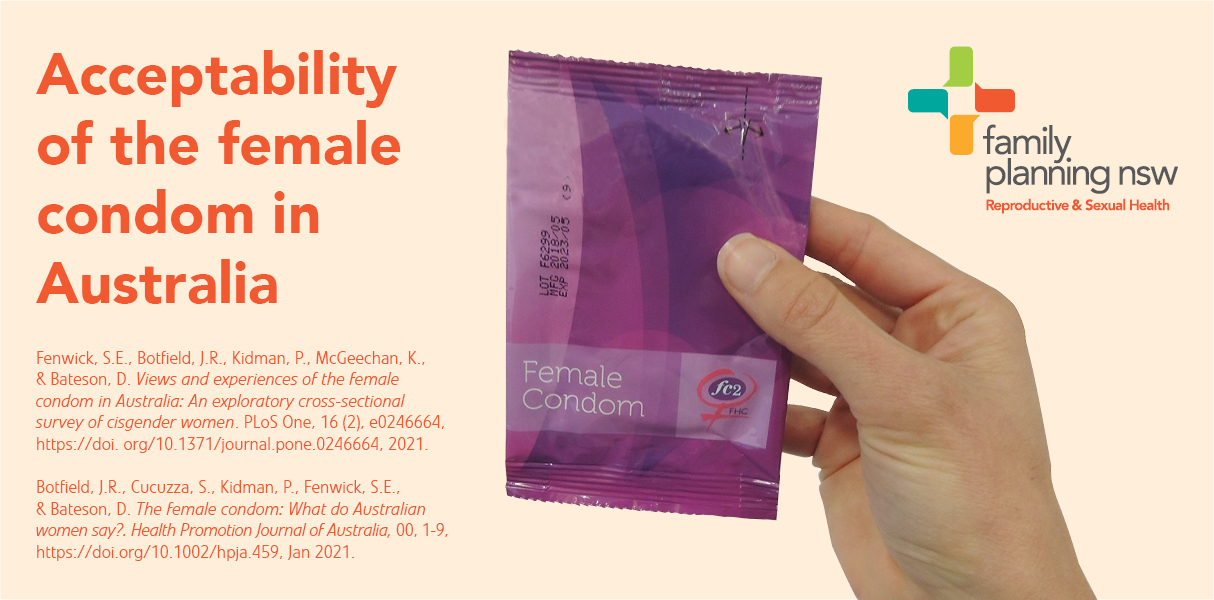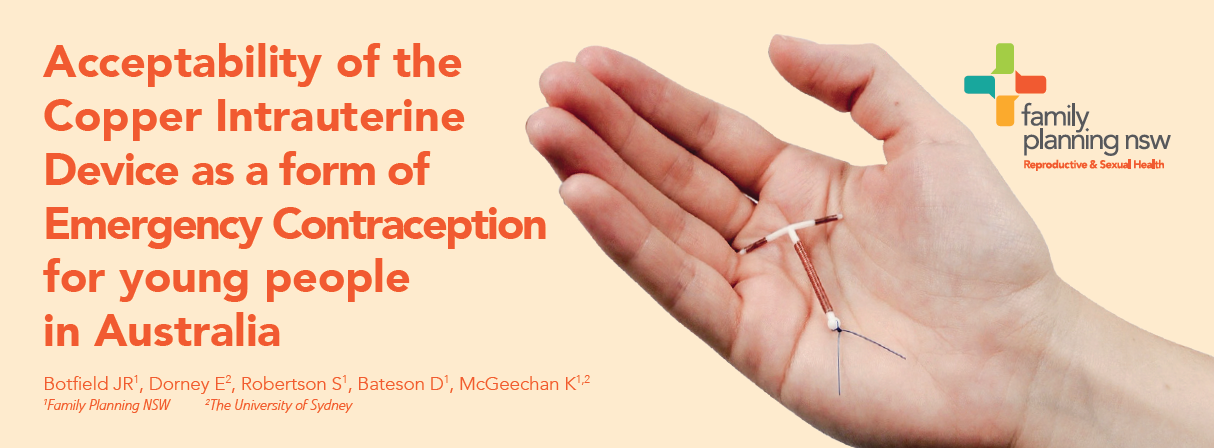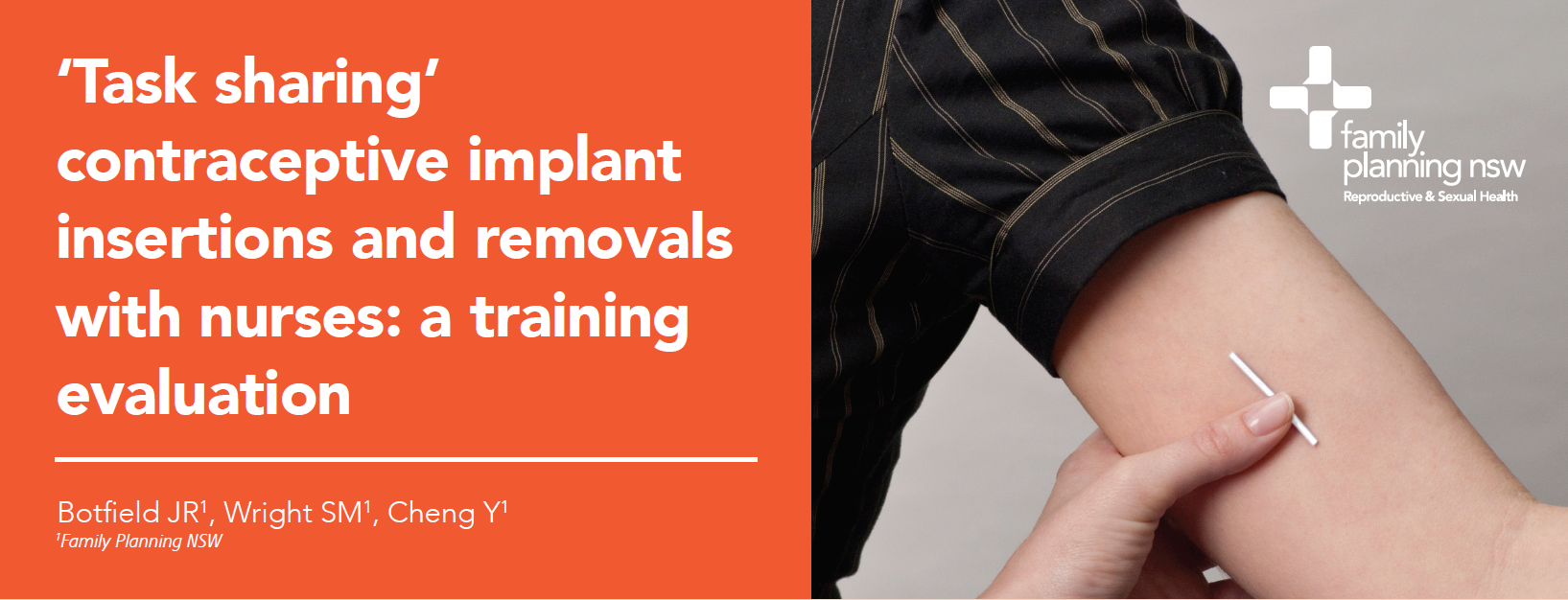Research Highlights
Acceptability of the female condom in Australia
The female condom. How acceptable is it to Australian women? The female/internal condom is the only female-initiated form of protection against unintended pregnancy and sexually transmissible infections (STIs). However, use of this method in Australia is low. Family Planning NSW conducted an interventional cross-sectional study which aimed to explore the views and experiences of women in NSW regarding the female condom. Cisgender women ≥16 years, heterosexually active and living in New South Wales were recruited through social media advertisements and email invitations to clients of a family planning service. Eligible participants were provided with three female condoms and invited to complete a follow-up survey. Survey responses for women who attempted to use at least one female condom were summarised using counts and proportions. Findings highlight the need for increased health promotion and education regarding use of the female condom. To increase access it will be important to address method cost and availability in Australia. Future research should explore other perspectives of this method, including among the LGBTIQ+ community. (This is an investigator-initiated study, partially funded by the Female Health Company, and with FC2 female condoms provided by GLYDE Health. Ethics approval for the study was obtained from the Family Planning NSW Human Research Ethics Committee (approval #R2018-08)).
Fenwick, S.E., Botfield, J.R., Kidman, P., McGeechan, K., & Bateson, D. Views and experiences of the female condom in Australia: An exploratory cross-sectional survey of cisgender women. PLoS One, 16 (2), e0246664, https://doi.org/10.1371/journal.pone.0246664, 2021.
Botfield, J.R., Cucuzza, S., Kidman, P., Fenwick, S.E., & Bateson, D. The female condom: What do Australian women say?. Health Promotion Journal of Australia, 00, 1-9, https://doi.org/10.1002/hpja.459, Jan 2021.

Contraception provision in the postpartum period: Knowledge, reviews and practices of midwives
Women are susceptible to unintended pregnancies in the first year after giving birth, particularly as consideration of contraception may be a low priority during this time. Discussing and providing contraception before women leave hospital after giving birth may prevent rapid repeat pregnancy and its associated risks. Midwives are well placed to assist with contraceptive decision-making and provision; however, this is not routinely undertaken by midwives in the Australian hospital setting and little is known regarding their views and experiences in relation to contraception. An anonymous survey was conducted with midwives at two urban hospitals in New South Wales to better understand their contraceptive knowledge, views and practices regarding midwifery-led contraception provision in the postpartum period. The survey was completed by 128 midwives. Most agreed that information about contraception provided in the postpartum period is valuable to women, although their knowledge about different methods was variable. The majority (88%) believed that midwives have a role in providing contraceptive information, and 79% reported currently providing contraceptive counselling. However, only 14% had received formal training in this area. Findings demonstrate that most midwives provide some contraception information and believe this is an important part of a midwife’s role. Yet most have not undertaken formal training in contraception. Additional research is needed to explore the content and quality of midwives’ contraception discussions with women. Training midwives in contraceptive counselling would ensure women receive accurate information about available options. Up-skilling midwives in contraception provision may increase postpartum uptake and reduce rapid repeat pregnancies.
Botfield, J.R., Tulloch, M., Contziu, H., Phipps, H., Bateson, D., Wright, S.M., McGeechan, K., & Black, K.I. Contraception provision in the postpartum period: Knowledge, reviews and practices of midwives. Women and Birth, 34(1), e1-e6, https://doi.org/10.1016/j.wombi.2020.07.013, Feb 2021.
Nurse-led implant insertions: Implications for clinical practice in Australia
Nurse-led contraceptive implant procedures are an accepted practice internationally; however this is not common practice in Australia. Family Planning NSW conducted a study to explore the effectiveness of contraceptive implant training on nurse-led insertions and removals, as well as its possible impact on clinical service delivery. Registered Nurses who participated in the Implanon NXT® Insertion and Removal Training Course, as well as their supervising clinicians, took part in the study. After training, all nurses were deemed competent in implant insertions and removals, and nurses felt positively about their increased scope of practice and ability to offer this procedure to patients. Supervising clinicians similarly felt that nurses could play a greater role in the provision of contraceptive implant procedures in Australia, although funding constraints were raised as a current limitation.
Botfield, J.R., Wright, S.M., Fenwick, S. E., & Cheng, Y. Training nurses in contraceptive implant procedures: implications for practice in Australia. Collegian, 28(1), 114-120, https://doi.org/10.1016/j.colegn.2020.04.005, Feb 2021.
National Cervical Screening Program renewal in Australia: survey of clinician views and attitudes
From 1 December 2017, the National Cervical Screening Program was renewed in Australia, with updated national cervical screening guidelines released. This study was performed to determine clinicians’ familiarity with the updated guidelines and explore their views and attitudes towards the renewed program. Clinicians providing cervical screening in New South Wales, Australia, were invited to complete an online survey in 2018. Of the 241 clinicians who responded, 91.5% supported the change to 5-yearly human papillomavirus screening from the age of 25 years. However, nearly 13% indicated they did not know where to access the renewed guidelines and 37% had never or rarely accessed them. Open-ended responses highlighted clinicians’ concerns about missed cancers and missed opportunities for health checks. Those raising these concerns accessed the guidelines less frequently. The findings highlight important areas for additional education and support for clinicians in translating guidelines into practice to ensure successful delivery of the renewed program.
Sweeney, S., Cheng, Y., Botfield, J.R., & Bateson, D. National Cervical Screening Program renewal in Australia: survey of clinician views and attitudes. Australian Journal of Primary Health, 26(5), 410-416, https://doi.org/10.1071/PY20032, Sept 2020.
A case control study to examine the cervico-vaginal microbiota associated with pelvic inflammatory disease
This is a case-control study comparing women presenting with pelvic inflammatory disease (PID) (cases), and women presenting for routine cervical and/or sexually transmitted infection screening (controls) to examine the cervico-vaginal microbiota associated with PID. Currently, there is limited understanding of the association of the cervico-vaginal microbiota with PID.
The study design is a case-control study with prospective recruitment of women presenting with PID and asymptomatic women presenting for routine cervical or sexual health screening. Cervical and posterior vaginal fornix specimens are collected for the study for microbiota and host gene expression analysis. Participant demographic data, clinical chart review to ensure consistency of recruitment and response to treatment of PID cases, and self-collected questionnaire on sexual, reproductive, and gynaecological history were also analysed. Antibiotic treatment in the month preceding recruitment and pregnancy were exclusion criteria.
The study is still progressing, to date 38 control participants have been recruited and 20 PID cases. The analysis indicates that Lactobacillus iners (referred to as community state type 3) dominant vaginal microbial communities were significantly more frequently detected in cases. Additionally, cases were significantly more likely to have taken antibiotics in the past year, had recent partner change and/or self-reported vaginal symptoms such as thrush or BV in the preceding 3 months. These are all factors which would potentially impact vaginal microbiota.
Pelvic inflammatory disease is known to be associated with sexual behaviour but a sexually transmitted infection is not always detected in PID. Here, we have found preliminary indications that a microbiota previously associated with sexually transmitted infection risk is also associated with PID. This is pilot data and further numbers are needed before conclusions can be reached.
Huston, W., Mazraani, R., Burke, C., Ravel, J., Fleming, K., Sweeney, S., & Bateson, D. A case control study to examine the cervico-vaginal microbiota associated with pelvic inflammatory disease. Sexually Transmitted Infections, 95(1), 2020.
Acceptability of the copper intrauterine device as emergency contraception
This project aimed to explore the knowledge and experiences of clients and clinicians in NSW, regarding the use of the copper intrauterine device (Cu-IUD) as a form of emergency contraception (EC). A cross-sectional convenience study was conducted by Family Planning NSW, which involved over 450 family planning clients and more than 50 NSW-practicing clinicians, who completed an anonymous online survey. Findings from the study suggested that many clients were unaware of the Cu-IUD as an option for EC, however nearly 50% would consider future use of this method. Cost and possible side-effects were identified as potential barriers. Clinicians were more likely to discuss the oral EC than the Cu-IUD, with time pressures reported as the main barrier. There is a need for increased education and promotion strategies for the Cu-IUD as EC in order to increase awareness of choice of options.
Dorney, E., Botfield, JR., Robertson, S., McGeechan, K., & Bateson, D., Acceptability of the copper intrauterine device as a form of emergency contraception in New South Wales, Australia. The European Journal of Contraception and Reproductive Health Care, 25(2), 114-119, Feb 2020

Nurse-led implant insertions: Implications for clinical practice in Australia
Nurse-led contraceptive implant procedures are an accepted practice internationally; however this is not common practice in Australia. Family Planning NSW conducted a study to explore the effectiveness of contraceptive implant training on nurse-led insertions and removals, as well as its possible impact on clinical service delivery. Registered Nurses who participated in the Implanon NXT® Insertion and Removal Training Course, as well as their supervising clinicians, took part in the study. After training, all nurses were deemed competent in implant insertions and removals, and nurses felt positively about their increased scope of practice and ability to offer this procedure to patients. Supervising clinicians similarly felt that nurses could play a greater role in the provision of contraceptive implant procedures in Australia, although funding constraints were raised as a current limitation.
Botfield, JR., Wright, SM., Fenwick, SE., Cheng, Y. Training nurses in contraceptive implant procedures: Implications for practice in Australia. Collegian, available online, 7, Aug 2020

Cost-benefit analysis of long-acting reversible contraception (LARC) uptake in Australia
A cost-benefit analysis was undertaken to assess the impact of increasing the uptake of long acting reversible contraceptives (LARCs; i.e., contraceptive implants and intrauterine devices) in Australia. The analysis focused on three scenarios:
- Scenario 1: Switching from an oral contraceptive pill (OCP) to a LARC.
- Scenario 2: Initiating the use of a LARC for women not currently using any form of contraception.
- Scenario 3: Impact of nurse-led LARC insertions.
Findings showed that an increase in LARC use would result in a net gain in economic benefits to Australia, due to reduced costs for women switching from an OCP to LARC, as well as a reduction in costs associated with unintended pregnancies for women not using contraception but wishing to avoid pregnancy. Enabling nurse-led LARC insertions would also facilitate access to LARC methods, and is a cost-effective way of increasing uptake. The creation of Medicare Benefits Schedule item numbers for RNs appropriately trained in LARC insertion would have benefits for both women and the Australian government.
The Centre for International Economics was commissioned by Family Planning NSW to conduct the economic modelling and analysis.
Concepcion, K., Lacey, S., McGeechan, K., Estoesta, J., Bateson, D., Botfield, JR., Cost–benefit analysis of enhancing the uptake of long-acting reversible contraception in Australia, Australian Health Review, available online, https://doi.org/10.1071/AH18190, Oct 2019
Botfield, JR., Lacey, S., Fleming, K., McGeechan, K., & Bateson, D. (2020) Increasing the accessibility of long-acting reversible contraceptives through nurse-led insertions: A cost-benefit analysis. Collegian, 27(1), 109-114.




